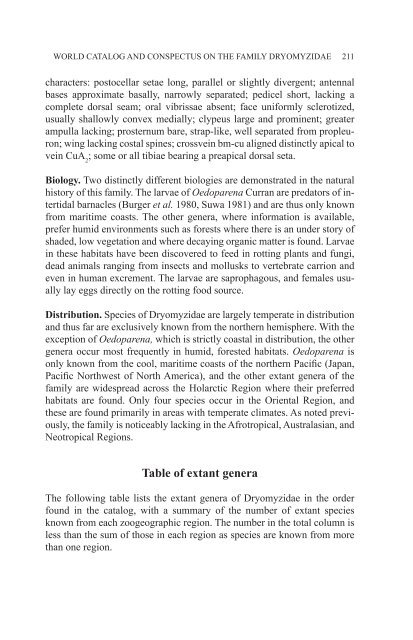World Catalog and Conspectus on the Family Dryomyzidae (Diptera ...
World Catalog and Conspectus on the Family Dryomyzidae (Diptera ...
World Catalog and Conspectus on the Family Dryomyzidae (Diptera ...
You also want an ePaper? Increase the reach of your titles
YUMPU automatically turns print PDFs into web optimized ePapers that Google loves.
WORLD CATALOG AND CONSPECTUS ON THE FAMILY DRYOMYZIDAE 211<br />
characters: postocellar setae l<strong>on</strong>g, parallel or slightly divergent; antennal<br />
bases approximate basally, narrowly separated; pedicel short, lacking a<br />
complete dorsal seam; oral vibrissae absent; face uniformly sclerotized,<br />
usually shallowly c<strong>on</strong>vex medially; clypeus large <str<strong>on</strong>g>and</str<strong>on</strong>g> prominent; greater<br />
ampulla lacking; prosternum bare, strap-like, well separated from propleur<strong>on</strong>;<br />
wing lacking costal spines; crossvein bm-cu aligned distinctly apical to<br />
vein CuA 2 ; some or all tibiae bearing a preapical dorsal seta.<br />
Biology. Two distinctly different biologies are dem<strong>on</strong>strated in <strong>the</strong> natural<br />
history of this family. The larvae of Oedoparena Curran are predators of intertidal<br />
barnacles (Burger et al. 1980, Suwa 1981) <str<strong>on</strong>g>and</str<strong>on</strong>g> are thus <strong>on</strong>ly known<br />
from maritime coasts. The o<strong>the</strong>r genera, where informati<strong>on</strong> is available,<br />
prefer humid envir<strong>on</strong>ments such as forests where <strong>the</strong>re is an under story of<br />
shaded, low vegetati<strong>on</strong> <str<strong>on</strong>g>and</str<strong>on</strong>g> where decaying organic matter is found. Larvae<br />
in <strong>the</strong>se habitats have been discovered to feed in rotting plants <str<strong>on</strong>g>and</str<strong>on</strong>g> fungi,<br />
dead animals ranging from insects <str<strong>on</strong>g>and</str<strong>on</strong>g> mollusks to vertebrate carri<strong>on</strong> <str<strong>on</strong>g>and</str<strong>on</strong>g><br />
even in human excrement. The larvae are saprophagous, <str<strong>on</strong>g>and</str<strong>on</strong>g> females usually<br />
lay eggs directly <strong>on</strong> <strong>the</strong> rotting food source.<br />
Distributi<strong>on</strong>. Species of <strong>Dryomyzidae</strong> are largely temperate in distributi<strong>on</strong><br />
<str<strong>on</strong>g>and</str<strong>on</strong>g> thus far are exclusively known from <strong>the</strong> nor<strong>the</strong>rn hemisphere. With <strong>the</strong><br />
excepti<strong>on</strong> of Oedoparena, which is strictly coastal in distributi<strong>on</strong>, <strong>the</strong> o<strong>the</strong>r<br />
genera occur most frequently in humid, forested habitats. Oedoparena is<br />
<strong>on</strong>ly known from <strong>the</strong> cool, maritime coasts of <strong>the</strong> nor<strong>the</strong>rn Pacific (Japan,<br />
Pacific Northwest of North America), <str<strong>on</strong>g>and</str<strong>on</strong>g> <strong>the</strong> o<strong>the</strong>r extant genera of <strong>the</strong><br />
family are widespread across <strong>the</strong> Holarctic Regi<strong>on</strong> where <strong>the</strong>ir preferred<br />
habitats are found. Only four species occur in <strong>the</strong> Oriental Regi<strong>on</strong>, <str<strong>on</strong>g>and</str<strong>on</strong>g><br />
<strong>the</strong>se are found primarily in areas with temperate climates. As noted previously,<br />
<strong>the</strong> family is noticeably lacking in <strong>the</strong> Afrotropical, Australasian, <str<strong>on</strong>g>and</str<strong>on</strong>g><br />
Neotropical Regi<strong>on</strong>s.<br />
Table of extant genera<br />
The following table lists <strong>the</strong> extant genera of <strong>Dryomyzidae</strong> in <strong>the</strong> order<br />
found in <strong>the</strong> catalog, with a summary of <strong>the</strong> number of extant species<br />
known from each zoogeographic regi<strong>on</strong>. The number in <strong>the</strong> total column is<br />
less than <strong>the</strong> sum of those in each regi<strong>on</strong> as species are known from more<br />
than <strong>on</strong>e regi<strong>on</strong>.

















